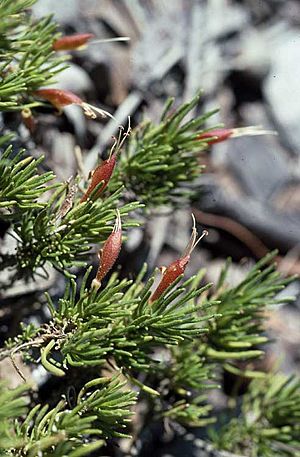Earth-loving poverty bush facts for kids
Quick facts for kids Earth-loving eremophila |
|
|---|---|
 |
|
| Conservation status | |
| Scientific classification | |
| Genus: |
Eremophila (plant)
|
| Species: |
chamaephila
|
| Synonyms | |
|
Pholidia chamaephila (Diels) Diels ex Kraenzl. |
|
The Eremophila chamaephila, also known as the earth-loving poverty bush, is a special flowering plant. It belongs to the figwort family, called Scrophulariaceae. This plant is only found in the southwest part of Western Australia. It's a low, bushy shrub with small, soft leaves and pretty purple flowers.
Contents
What Does It Look Like?
The Eremophila chamaephila is a small, spreading shrub that grows close to the ground. It usually reaches about 0.25 m (0.8 ft) high and can spread out to 0.8 m (3 ft) wide. Its branches are a bit lumpy, and its leaves grow one after another along them. The leaves are small, about 2.5–7 mm (0.1–0.3 in) long and 1 mm (0.04 in) wide. They are dark green, sometimes turning purplish at the tips, and also have small bumps on their underside.
The flowers grow one by one where the leaves meet the stem. They don't have a stalk. Each flower has 5 green or purplish parts called sepals, which are 2–4 mm (0.08–0.2 in) long and lumpy. The petals are 5.5–7 mm (0.2–0.3 in) long and form a tube at the bottom. The outside of the flower tube is purple, and the inside is white with purple spots. The outside is smooth, but the inside is hairy. The 4 stamens (the parts that hold pollen) stick out a little from the end of the flower tube. This plant flowers from October to December. After flowering, it produces small, round fruits, about 2–3 mm (0.08–0.1 in) across. These fruits are a bit soft when fresh but get wrinkled when dry.
How It Got Its Name
This plant was first officially described by a scientist named Ludwig Diels in 1905. The name chamaephila comes from ancient Greek words. Chamae means "lowly" or "creeping," and philus means "loving." So, "earth-loving" describes how this plant grows low to the ground.
Where Does It Grow?
You can find Eremophila chamaephila north of Esperance in Western Australia. It grows in the area between Ravensthorpe and Grass Patch. It likes to grow in sand or clay soils, and you often see it in places where the ground has been disturbed, like along roadsides.
Is It Protected?
The Western Australian Government Department of Parks and Wildlife has classified Eremophila chamaephila as "Priority Three". This means that we don't know a lot about this plant, and it's only found in a few places. However, it's not currently in immediate danger of disappearing. Protecting these plants helps keep our natural world healthy and diverse.
Growing It at Home
The earth-loving poverty bush is a great choice if you want a small, compact shrub for your garden. It can be used as a very low hedge, along the edge of a path, or even in a pot. You can grow new plants from cuttings, though it might take a few months for roots to form, especially in warmer weather. It can also be grafted onto other plants like Myoporum species. This plant likes soil that drains well, but it can handle dry periods and is tough enough to survive frost.


